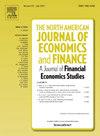Risky finance, riskier climate: when financial instability meets climate risks on the bridge of sustainability uncertainty
IF 3.9
3区 经济学
Q1 BUSINESS, FINANCE
North American Journal of Economics and Finance
Pub Date : 2025-06-18
DOI:10.1016/j.najef.2025.102492
引用次数: 0
Abstract
This study bridges two critical literatures: climate-related finance theory, which focuses on the destabilizing effects of climate risks on financial markets, and corporate social responsibility (CSR) theory, rooted in the shareholder-stakeholder debate. In doing so, it provides one of the first attempts to explore the systemic interactions between financial instability, sustainability uncertainty, and climate risks. Leveraging the novel U.S. ESG-based Sustainability Uncertainty Index (ESGUI; Ongan et al., 2025) and employing a Time-Varying Parameter Vector Autoregression (TVP-VAR) connectedness framework, we analyze how shocks stemming from financial market stress, ESG investment and policy uncertainty, and climate-related risks propagate and interact across major financial, political, and environmental events in the U.S. economy from 2003 to 2024. The main findings reveal that credit market stress and volatility-driven financial uncertainty act as the major transmitters of instability in the system, with connectedness peaking during 2008–2009 and 2020–2022. However, the transmission of financial instability to climate risks is nonlinear and contingent on sustainability uncertainty. Interestingly, regulatory responses, such as post-Global Financial Crisis reforms and the Paris Agreement, help temporarily mitigate but fail to fully eliminate risk spillovers. These results are robust to the application of the time-varying robust Granger causality test, which serves as an alternative validation approach.
风险金融,风险气候:当金融不稳定在可持续性不确定性的桥梁上遇到气候风险
本研究结合了两种重要文献:气候相关金融理论(侧重于气候风险对金融市场的不稳定影响)和企业社会责任(CSR)理论(植根于股东-利益相关者之争)。在此过程中,它首次尝试探索金融不稳定性、可持续性不确定性和气候风险之间的系统性相互作用。利用美国基于esg的新型可持续性不确定性指数(ESGUI);Ongan et al., 2025),并采用时变参数向量自回归(TVP-VAR)连通性框架,分析了2003年至2024年期间,金融市场压力、ESG投资和政策不确定性以及气候相关风险引发的冲击如何在美国经济中的主要金融、政治和环境事件中传播和相互作用。主要研究结果显示,信贷市场压力和波动驱动的金融不确定性是系统不稳定性的主要传导因素,连通性在2008-2009年和2020-2022年达到峰值。然而,金融不稳定向气候风险的传导是非线性的,且取决于可持续性的不确定性。有趣的是,监管应对措施,如全球金融危机后的改革和《巴黎协定》,有助于暂时缓解风险溢出,但未能完全消除风险溢出。这些结果对于时变稳健格兰杰因果检验的应用是稳健的,这是一种替代的验证方法。
本文章由计算机程序翻译,如有差异,请以英文原文为准。
求助全文
约1分钟内获得全文
求助全文
来源期刊
CiteScore
7.30
自引率
8.30%
发文量
168
期刊介绍:
The focus of the North-American Journal of Economics and Finance is on the economics of integration of goods, services, financial markets, at both regional and global levels with the role of economic policy in that process playing an important role. Both theoretical and empirical papers are welcome. Empirical and policy-related papers that rely on data and the experiences of countries outside North America are also welcome. Papers should offer concrete lessons about the ongoing process of globalization, or policy implications about how governments, domestic or international institutions, can improve the coordination of their activities. Empirical analysis should be capable of replication. Authors of accepted papers will be encouraged to supply data and computer programs.

 求助内容:
求助内容: 应助结果提醒方式:
应助结果提醒方式:


